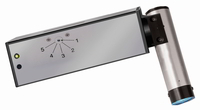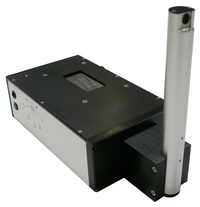Surface Quality Monitors
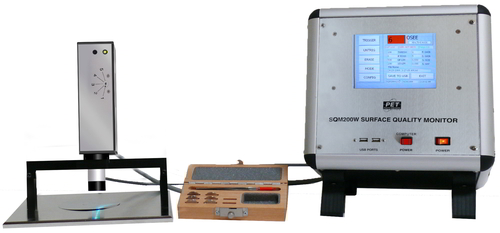
PET manufactures and markets non-destructive, non-contact surface contamination and thin film detection models and automated systems (surface quality monitoring system) capable of detecting thin layer contamination, thin films and coating down to the Angstrom level. These systems represent a major breakthrough by providing, for the first time, a quantitative measure of surface cleanliness. As surface cleanliness verification instruments, in a part cleaning environment, these products are capable of validating the cleaning quality of all the part cleaning equipment available in the market. Any of SQM model series is capable of verifying metal contamination; monitoring absence/presence of organic and/or inorganic on virtually on surfaces of all metals. They are, price/performance, the most sufficient product available for testing surface of metals for surface cleanliness. These systems operate in an ambient environment, require no sample preparation or deposit of any agents on the surface. In any parts cleaning environment where the quality and efficiency of part cleaning equipment for removal of surface contamination is highly desired, these systems provide a scientific solution by quantitatively measuring the surface cleanliness. The SQM series has the sensitivity and operational simplicity required to provide fast and cost effective surface evaluation for all metals.
SURFACE QUALITY MONITORS MODELS
SQM200W
A single channel system for measuring surface cleanliness or monitoring absence/presence of organic/inorganic thin films or measuring the relative thickness of very thin films. System features include upper and lower acceptance limits, go/no go indicators and analog signal output.
SQM300W
A single channel system for measuring surface cleanliness or monitoring absence/presence of organic/inorganic thin films or measuring the relative thickness of very thin films. System features include upper and lower acceptance limits, go/no go indicators, process control chart, automatic data storage, inspection procedure information stored for unlimited different parts/components and analog signal output.
SQM500W
An integrated turn-key scanning, data acquisition and 3-D color graphics system for scanning a flat surface to help make NON-VISIBLE contaminants/coatings become VISIBLE through a color mapping technique. The system includes a SQM200W system with motor driven and software controlled X-Y scanning table with 6” x 6”. Stages with larger travel are optional. This system is a powerful tool for studying and monitoring surface chemistry variations.
SQM600W
An integrated turn-key scanning, data acquisition and 3-D color graphics system for scanning a flat surface to help make NON-VISIBLE contaminants/coatings become VISIBLE through a color mapping technique. The system includes a SQM200W system with motor driven and software controlled rotary scanning table and a linear slide. This system is a powerful tool for studying and monitoring surface chemistry variations.
OSEE APPLICATIONS
SURFACE CLEANLINESS MONITORING & VERIFICATION
- Detect both organic and inorganic contamination.
- Quantitatively establish the level of cleanliness achieved by the existing cleaning process.
- Establish an acceptable range of quantitative measurement for surface cleanliness.
- Evaluate the effectiveness of new and potential cleaning processes.
- Optimize cleaning processes by measuring changes in the surface cleanliness level as a result of changes made to cleaning processes.
- Monitor cleaning processes on an ongoing basis to assure that an acceptable level of cleanliness is achieved.
- Prevent product quality problems due to poor surface cleanliness.
- Optimize and monitor the rinse cycle to insure that parts have been properly rinsed.
- Replace water break and other qualitative tests with a quantitative measurement of surface cleanliness.
LUBRICANTS, COATINGS OR THIN FILMS
- Detect absence or presence of invisible, clear thin films, coatings or lubricants on virtually any surface.
- Monitor the relative thickness of very thin films, coatings or lubricants, both off-line and on-line.
CHANGES IN CHEMICAL STATE OF ANY SURFACE
- Detect micro changes in the chemical state of any surface.
- Monitor parts or witness panels for deposition of Airborne Molecular Contamination (AMC's)
- Monitor for deposition of contaminants due to out gassing of storage containers or packing materials.
- Indirect monitoring of blind holes and small chambers for contamination.
BENEFITS
- Stop over-cleaning and reduce cleaning agent use.
- Reduce rejects & reworks.
- Improve coating & paint adhesion.
- Improve bond strength.
- Increase productivity by optimizing cleaning processes and maximize environmental protection.
APPLICATIONS ASSISTANCE
Photo Emission will advise customers of the applicability of our systems for their specific applications. In addition, Photo Emission will perform tests on customer supplied samples and write a test report to demonstrate the usefulness of our systems for the customer's application. Please contact us with your application requirements. Photo Emission also manufactures custom system and sensor configurations for special applications.
COMPARISON CHART FOR SQM200W and SQM300
| Items | Feature | Description | SQM200W | SQM300 |
| 1 | Peak Detect Mode | Detect & record peak OSEE reading | Yes | Yes |
| 2 | Continuous Mode | OSEE reading changes as sensor or sample moved | Yes | Yes |
| 3 | Timed Mode | Measure & record readings at user defined interval | Yes | Yes |
| 4 | Film Thickness Mode | Measure & record rthin film thickness as per predefined relationship | No | Yes |
| 5 | Process Control Chart | Displays the readings to plot the process control chart | No | Yes |
| 6 | Automatic Data Saving (Not In Realtime Mode) | Saves data in a file | Yes | Yes |
| 7 | User Defined File Name | User can define the name of the file in which to save the data | No | Yes |
| 8 | Number Of Files | Number of files that can be saved | Unlimited | Unlimited |
| 9 | Display Mean | Updates, calculates and displays OSEE mean | Yes | Yes |
| 10 | Display Standard Deviation | Updates, calculates and displays standard deviation of OSEE | Yes | Yes |
| 11 | Go/No Go Display | Gives accept/reject information | Yes | Yes |
| 12 | Set Upper/Lower Acceptance Limits | Allows the user to set up acceptable range of readings | Yes | Yes |
| 13 | USB Port | Yes | Yes | |
| 14 | Keyboard & Mouse Interface | Yes | Yes | |
| 15 | Display (Touch Screen) | Small (6") | Large (12.4") | |
| 16 | Internet connection | Yes | Yes | |
| 17 | Calibration Date & Reminder | Yes | Yes | |
| 18 | Host Computer Commmunication | Yes | Yes |
OSEE THEORY

The SQM Series instruments are based on the principle known as Optically Stimulated Electron Emission (OSEE), also known as Photo Electron Emission (PEE). It is a well known fact that when metals or certain other surfaces are illuminated with ultraviolet light of the proper wavelength (energy), electrons are emitted from the surface. The process by which UV photons interact with the surface to produce electrons is known as OSEE. The emitted and subsequently scattered electrons can be collected across an air gap by a biased collector (located at the end of the the OSEE sensor), and measured as a current. By maintaining the surface to collector distance relatively constant, changes in the measured photocurrent (which is in the order of 10-10 amps) can provide information about the surface, e.g., electronic structure, composition, and chemistry. Any contaminant on the surface, depending on its own photoemission characteristics, can either enhance or attenuate the inherent emission from the surface. In simple electronic terms, the surface is a current generator, and a non-photoemitting contaminant acts as a resistance, because the current is attenuated by interactions between the electrons and the contaminant. The thicker the contaminant, the higher the resistance, and consequently the greater the decrease in the measured signal.
The Sensor response to various materials generally depends on the magnitude of the photoelectron work function. Generally, materials with a work function of less than approximately seven EV (electron volts) will produce a photocurrent. Both conducting and non-conducting materials can be photoemissive. For example, epoxy primer, carbon phenolic, glass phenolic, graphite/epoxy, and fiberglass/epoxy will emit. Most plastics and ceramics are photoemissive. Some materials that have extremely low response include pure teflon, pure glass, and magnesium fluoride. In general measurements can be made on most materials of engineering importance, proving OSEE of great practical use.
The presence of thin contaminant films on surfaces can result from inadequate or incomplete cleaning methods, from oxide growth after cleaning, or from failure to properly protect cleaned surfaces from oils, greases, fingerprints, release agents, or deposition of facility airborne molecules generated by adjacent manufacturing or processing operations. Often these contaminants are invisible, making detection and quantitative measurement difficult and expensive. The SQM Series has the sensitivity and operational simplicity required to provide fast and cost effective surface evaluations.
OSEE SENSORS
Seven standard sensor configurations are offered. Not all of them are listed or shown here. Sensor Part Numbers marked with an * are the standard sensors included with the respective system. Any of the other sensors may be substituted for the standard sensor at no additional cost. These sensors have been designed to adapt to various applications. Inspectable areas vary from 1/16" (1.5 mm) diameter (with the use of apertures on the standard sensor) to 6" x 1/4" (155 mm x 6 mm). The type of sensor appropriate for any application depends on the required spatial resolution and the size of the surface to be inspected. Photo Emission will assist in selection of appropriate sensors for you application.
|
||||
 Vertical Sensor (PN#60792) Area Inspected: ~0.95in2 |
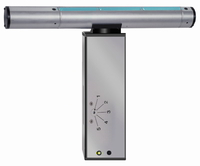 6 Inch Sensor (PN#60780) Area Inspected: 6" x 1/4" |
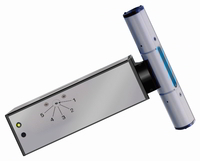 2 Inch Sensor (PN#60779) Area Inspected: 2" x 1/4" |
||
|
||||
DATA ACQUISITION
The SQM Series Surface Quality Monitors can be interfaced with PETSCANTM (SQM500W) or ROTOSCANTM (SQM600W), integrated data acquisition and three-dimensional graphic systems. The SQM500W System is for scanning flat surfaces whereas the SQM600W System is for scanning the inside or outside surface of a cylinder. These systems are used to scan a part and acquire data from the surface with an OSEE sensor, and generate a color map which displays any variation in surface condition. The software for these systems has very powerful features for displaying data in a graphics format, with ZOOM and PAN capabilities. With these systems it is possible to make NON-VISIBLE contaminants/coatings become VISIBLE through a color mapping technique. The SQM500W or SQM600W System includes an OSEE System, and is a very powerful tool for studying and monitoring the effectiveness of cleaning processes or variation in the thickness of very thin films or coatings. Please refer to the SQM500W or SQM600W brochure for additional information.
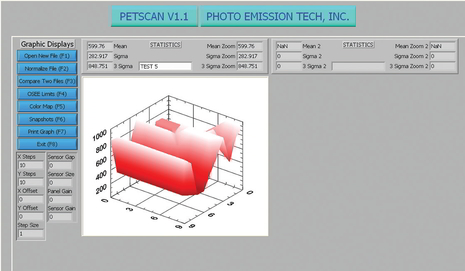
3-D Map of a Contaminated Surface

Color Map of Finger Print on Aluminum Surface
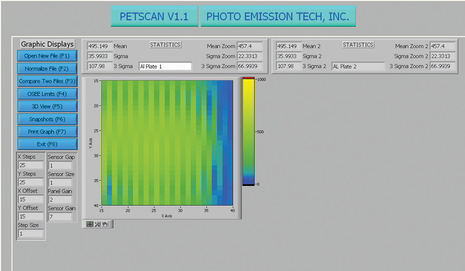
Color Map after Cleaning Aluminum Surface
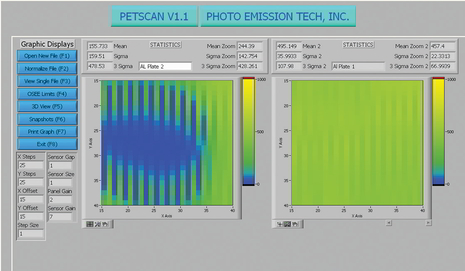
Comparison of before and after cleaning

